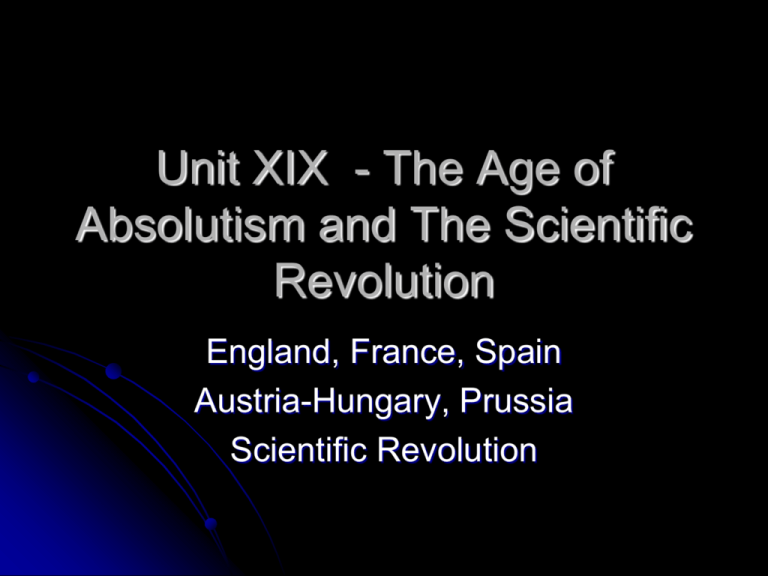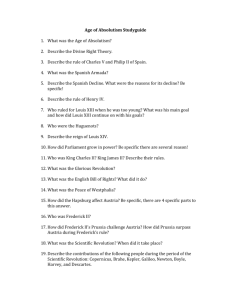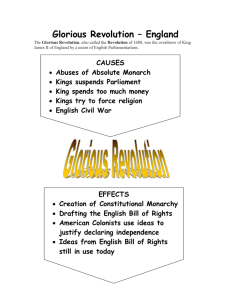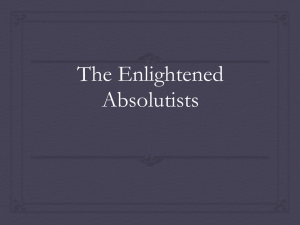Age of Absolutism Powerpoint
advertisement

Unit XIX - The Age of Absolutism and The Scientific Revolution England, France, Spain Austria-Hungary, Prussia Scientific Revolution 1. A Look at the Absolute Power of the Spanish, French, and English Kings from 1550 - 1800 A. What is the Age of Absolutism? The period of time during which kings of western Europe had absolute control over their national governments and societies. B. What is the Divine Right Theory? The theory that stated that kings had a god given right to rule their nations as they wished. 2. The Spanish Kings A. Charles V B. King Philip II 1. 1519-1556 2. Grandson of Ferdinand and Isabella 3. Also ruled the Holy Roman Empire 4. Constant warfare-with France, Protestants and Ottoman Empire 5. Became a monk 1. Son of Charles V 2. Ruled Spain, Netherlands, southern Italy and Americas 3. Centralized power 4. Absolute Monarch 5. Guardian of Catholic Church 6. Wars-Netherlands, Ottomans, Spanish Armada 7. Golden Century 8. Strong Spanish King 3. Philip II of Spain 4. The Decline of Spain What were the reasons for the decline of Spanish power? A. Defeat of the Spanish Armada B. Heavy taxes on middle class C. The drain on the treasury D. Neglect of farming and trade with the colonies E. The slowdown of gold F. The expulsion of Jews and Muslims 5. The Spanish Armada 6. The Kings of France A. Between 1560 and 1590 the wars between the French Huguenots (Protestants) and Catholics tore up France. B. Henry IV was a king who ruled France from 1589 – 1610. C. Armand Richelieu was a Roman Catholic Cardinal who ruled France upon His goal was to restore order to France and he tried to do this by issuing the Edict of Nantes in 1598. This proclamation gave religious toleration to the Huguenots and allowed them to fortify their cities to protect themselves. His goal was “a chicken in every pot” - food for all. He also wanted justice, improved roads and bridges, and to reduce the power of the nobles. the death of Henry IV because Louis XIII (Henry’s son) was too young to rule. When Louis was old enough he made Richelieu finance minister. Richelieu’s main goal was to destroy the power of the nobles and the Huguenots. He broke the power of the nobles and broke down the walls of the Huguenots but allowed them to practice their religion. 7. The Sun King – Louis XIV (1661-1733) A. “I am the State” B. The symbol of the sun C. No meetings of the Estates General D. The strongest army in Europe E. The splendor of Versailles F. Successes G. Failures H. “Balance of Power” 8. Louis XIV – The Sun King 9. A Different Story in England A. How did Parliament grow in power? 1. The annulments of Henry VIII 2. The Act of Supremacy 3. The ‘power of the purse” 4. Good Queen Bess – Elizabeth I (Tudor) 5. King James I (Stuart) v. Parliament 6. The English Civil War (1642-1649) 7. The execution of King Charles I 8. The Commonwealth 10. The Glorious Revolution A. Charles II was the King of England who was restored to power in 1660 and who ruled very well and worked with Parliament even though he believed in absolute monarchy (remember his father was executed) B. James II was the brother of Charles II who inherited the throne in 1685. He angered the people and Parliament quickly by appointing many Catholics to government positions and was replaced by William and Mary in 1688 (Mary was James’ Protestant daughter). C. The Glorious Revolution was the change of power without bloodshed from the reign of James II to the reign of William and Mary. (Catholic leaning and uncooperative to Protestant leaning and cooperative with Parliament) 12. The Bill of Rights in England 13. The Rise of Austria A. The Thirty Years War B. The Peace of Westphalia C. How did the Hapsburgs affect Austria? 1. they controlled Austria (Catholic) 2. they added Bohemia, and parts of Poland and Italy 3. they controlled very diverse groups and gave them some unity (Magyars, Slavs) 4. they never centralized authority like the other kings of Europe (2nd class kingdom) 14. The Austrian Empire 15. Prussia A. How did the Hohenzollerns from northeastern Germany unite many north German states into a country? 1. Frederick II inherited the throne in 1740 2. Frederick’s Prussia challenged Austria by taking Silesia from Austria and declaring independence, Frederick was a great warrior (Frederick the Great) 3. Frederick continued to win several later wars making Prussia a strong military power. 16. Map of Prussia 17. The Scientific Revolution A. What was the Scientific Revolution and when did it take place? 1. The change that took place in science starting in the mid 1500’s and continuing to the 1700’s. 18. People of the Scientific Revolution A. Niccolaus Copernicus - Polish, Heliocentric Theory B. Tycho Brahe – Danish, support of Copernicus C. Johannes Kepler – German, mathematician, orbits of the planets, birth date of Jesus D. Galileo Galilei – Italian, telescope, moon mts., sunspots, confirmed Copernicus, lenses E. Isaac Newton – English, mathematician gravity F. Robert Boyle – English, individual elements vs. chemical compounds 20. Accomplishments (cont.) G. Andreas Vesalius – Italian. detailed study of human anatomy H. Ambrose Pare – French, ointment preventing infection, stitching of wounds I. William Harvey – English, circulation of the blood J. Francis Bacon – English, experimental method to arrive at truth K. Rene Descartes – French, human reasoning is the best way to understand 21. The Tomb of Galileo Galilei in Florence 22. The Church of Santa Croce, Florence, Italy 24. Galileo Galilei






